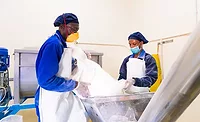Hashtags and Hazards: The Dubious Influence of Social Media Trends on Food Safety

Image credit: Franck via Unsplash
Social Media: A Double-Edged Sword
Social media posts like Instagram reels and TikTok videos have had positive impacts in the food safety landscape. They have helped raise awareness of best practices for handling food, empowering consumers to make more informed choices in their kitchens. They have also been used to identify foodborne illness outbreaks. Users can quickly share information about suspected foodborne illnesses and recalls, leading to earlier detection and containment of outbreaks by health authorities. In fact, researchers have explored using large-scale X (formerly Twitter) data to surveil foodborne illnesses and provide real-time information for detecting potential foodborne illness outbreaks.1
Social media can also be used as a trust-building tool. Consumers can now more readily engage with food businesses and manufacturers to ask questions about best practices and share concerns, promoting transparency and responsible food handling.
However, social media has also been used to spread misinformation and fear by generating sensationalized content that causes unnecessary panic and confusion among consumers. Headlines or excerpts from news reports or journal articles are picked up, and only snippets of the issue are spread. Without context or science-based information, consumers may become confused, afraid, and uncertain of best practices.
Safe Sips or Silent Threat?
Social media has been buzzing about viral videos showing Stanley tumbler cup owners testing their cups for lead with at-home testing kits. Allegedly, some of the tests returned positive results, which made people question if they should throw out their beloved reusable water bottles.
As with most things, it is more complicated than that. Yes, lead is used in these popular bottles. However, it is used in a welding pellet that seals together the double-wall vacuum insulation at the base of the product. While the pellet does contain lead, it is contained within the stainless steel and should not come in contact with skin or the liquid inside.
Looking for quick answers on food safety topics?
Try Ask FSM, our new smart AI search tool.
Ask FSM →
It could become an issue, but only if the bottle becomes damaged and the seal is loosened. Additionally, while these at-home lead tests are convenient and affordable, their accuracy and reliability are uncertain.2 Other reusable water bottles are available that use lead-free solders, if a consumer personally decides the risk is too great. Despite the best intentions of these videos, they illustrate where dubious information or uninformed context can incite fear and panic without understanding the full picture and the risks involved.
Be Serious About Leftovers
Lately, videos of creators emphasizing the potential dangers of reheated or leftover rice have appeared, emphasizing that it could lead to severe cases of food poisoning or even death. Some creators share personal experiences of feeling unwell after consuming leftover rice, pledging to avoid it in the future. The resounding message is clear: No leftover rice in 2024.
While scary claims about reheated rice continue to circulate on the internet, the truth is more nuanced. Uncooked rice can contain Bacillus cereus spores. If rice is left out too long, the spores can begin to germinate and produce heat-stable toxins. These toxins cannot be destroyed even with reheating in the microwave or on the stovetop. However, with proper storage of leftovers, reheated rice can be safe to eat.
According to the U.S. Department of Agriculture (USDA), leftover rice should be cooled rapidly to below 40 °F (4.4 °C) in the refrigerator. The best practice is to spread the rice out on a shallow container so that surface area is increased and the food cools more quickly. Rice that has been properly stored should be eaten within 4–6 days. Any rice left over after this time frame should be discarded.
While I am excited that there are many accounts encouraging people to "be serious" about how leftovers are stored and handled, there is a fear-mongering tone to some of these messages that do not leave the casual Instagram observer with the whole story and knowledge about the actual risk.
Stop Scrolling and Start Researching
These are but two recent trending topics, but this sensationalism of food safety issues continues year-round, touching food products and practices. In both cases, there are kernels of truth behind the warning messages cited above that are spreading on the internet.
However, many of the nuances of these problems are lost in the 60-second videos, reels, and TikToks that people are viewing. In many of these stories, there is an easy solution to protect consumer health. I encourage social media users to rededicate the same 60 seconds to investigating on their own. Visit credible information resources provided by USDA,3 the U.S. Food and Drug Administration (FDA),4 and the U.S. Centers for Disease Control and Prevention (CDC)5 to learn the facts and make science-based decisions for your health.
References
- Tao, D., R. Hu, D. Zhang, J. Laber, A. Lapsley, T. Kwan, L. Rathke, E. Rundensteiner, and H. Feng. "A Novel Foodborne Illness Detection and Web Application Tool Based on Social Media." Foods 12, no. 14 (July 2023): 2769. https://pubmed.ncbi.nlm.nih.gov/37509861/.
- Kriss, R., K.J. Pieper, J. Parks, and M.A. Edwards. "Challenges of Detecting Lead in Drinking Water Using at-Home Test Kits." Environmental Science and Technology 55, no. 3 (February 2021): 1964–1972. https://pubmed.ncbi.nlm.nih.gov/33428401/.
- U.S. Department of Agriculture. "Leftovers and Food Safety." Last updated July 31, 2020. https://www.fsis.usda.gov/food-safety/safe-food-handling-and-preparation/food-safety-basics/leftovers-and-food-safety.
- U.S. Food and Drug Administration. "Are You Storing Food Safely?" Current as of January 18, 2023. https://www.fda.gov/consumers/consumer-updates/are-you-storing-food-safely.
- Centers for Disease Control and Prevention. "Food Safety for Buffets and Parties." Last reviewed November 13, 2023. https://www.cdc.gov/foodsafety/serving-food-safely.html.









